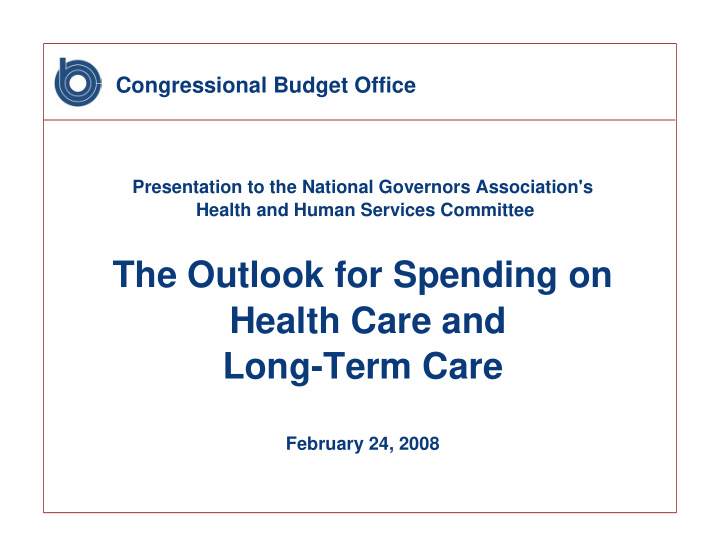



Congressional Budget Office Presentation to the National Governors Association's Health and Human Services Committee The Outlook for Spending on Health Care and Long-Term Care February 24, 2008
Federal Spending Under CBO’s Alternative Fiscal Scenario Percentage of GDP 40 Actual Projected 30 Medicare and Medicaid 20 Social Security 10 Other Spending (Excluding debt service) 0 1962 1972 1982 1992 2002 2012 2022 2032 2042 2052 2062 2072 2082
Sources of Growth in Projected Federal Spending on Medicare and Medicaid Percentage of GDP 20 15 10 Effect of Excess Cost Growth Effect of the Aging of the Population 5 0 2007 2012 2017 2022 2027 2032 2037 2042 2047 2052 2057 2062 2067 2072 2077 2082
Medicare Spending per Capita in the United States, by Hospital Referral Region, 2003 $7,200 to 11,600 (74) 6,300 to <6,800 (55) 4,500 to < 5,800 (72) 6,800 to < 7,200 (45) 5,800 to <6,300 (60) Not Populated Source: www.dartmouthatlas.org.
The Relationship Between Quality and Medicare Spending, by State, 2004 Composite Measure of Quality of Care 88 83 78 73 4,000 5,000 6,000 7,000 8,000 Spending (Dollars) Source: Data from AHRQ and CMS.
What Additional Services Are Provided in High-Spending Regions? Source: Elliot Fisher, Dartmouth Medical School.
Variations Among Academic Medical Centers Use of Biologically Targeted Interventions and Care-Delivery Methods Among Three of U.S. News and World Report ’s “Honor Roll” AMCs UCLA Massachusetts Mayo Clinic Medical General (St. Mary’s Center Hospital Hospital) Biologically Targeted Interventions: Acute Inpatient Care CMS composite quality score 81.5 85.9 90.4 Care Delivery ― and Spending ― Among Medicare Patients in Last Six Months of Life Total Medicare spending 50,522 40,181 26,330 Hospital days 19.2 17.7 12.9 Physician visits 52.1 42.2 23.9 Ratio, medical specialist / primary care 2.9 1.0 1.1 Source: Elliot Fisher, Dartmouth Medical School.
Medicaid Spending per Patient for Long-Term Care, 2005 Source: CBO calculations using data from Thomson Healthcare and the Medicaid Statistical Information System.
Medicaid Spending for Long-Term Care, by Type of Service Billions of Dollars 50 Skilled Nursing Facilities 40 Home and 30 Community-Based Services Waiver 20 Intermediate Care Facilities for the Mentally Retarded 10 Personal Care Home Health 0 1994 1995 1996 1997 1998 1999 2000 2001 2002 2003 2004 2005 2006 Source: Thomson Healthcare analysis using CMS 64 data. Note: Data include federal and state spending.
Spending for Long-Term Care, by Source, 2006 Not Including Informal Care Including Informal Care Other (5%) Medicaid (19%) Out-of-Pocket Payments (19%) Medicaid Medicare (45%) (10%) Informal Care Private Insurance (58%) (8%) Private Insurance Medicare (3%) (23%) Out-of-Pocket Payments Other (8%) (2%) Sources: CBO; CMS Office of the Actuary; and Arno, P., and others, "The Economic Value of Informal Caregiving," Health Affairs, vol. 18, no. 2 (2002).
The Number of Long-Term Care Insurance Policies Sold Thousands 800 700 600 500 400 300 200 100 0 1988 1990 1992 1994 1996 1998 2000 2002 2004 2006 Sources: CBO (based on conversations with industry experts) and data from AHIP.
Median Assets of Married People Ages 63 to 67 in the Population as a Whole and Within the Impaired Population, 2002 Thousands of Dollars 250 Total Assets 199.4 200 Net Nonhousing Assets 150 100 84.8 84.5 50 31.0 0 Impaired Population a Total Population Source: HRS/AHEAD. a. Impaired is defined as having three or more losses in the health activities of daily living.
Projections of the U.S. Elderly Population Percentage of Total Population 25 Age 65 and Older 20 15 10 5 Age 85 and Older 0 2000 2005 2010 2015 2020 2025 2030 2035 2040 2045 2050 Source: U.S. Bureau of the Census.
Increase in Life Expectancy and Increase in Difference in Life Expectancy by Economic Status Years 4 Increase in Average Life Expectancy, 1980–2000 Increase in Difference in Average Life Expectancy 3 Between Lowest and Highest Decile, 1980–2000 2 1 0 At Birth At Age 65 Source: Data from Singh and Siahpush (2006) and CDC.
CBO’s Activities in Analyzing Health Care � New Hires and Expanded Staffing – New deputy assistant director (Keith Fontenot) in the Budget Analysis Division – Increase in health staff agencywide from 30 FTEs to 40 FTEs (Plus 6 new hires) – FY 2009 plans � Reports and Analysis in 2008 – Critical Topics in Health Reform – Health Options
Recommend
More recommend